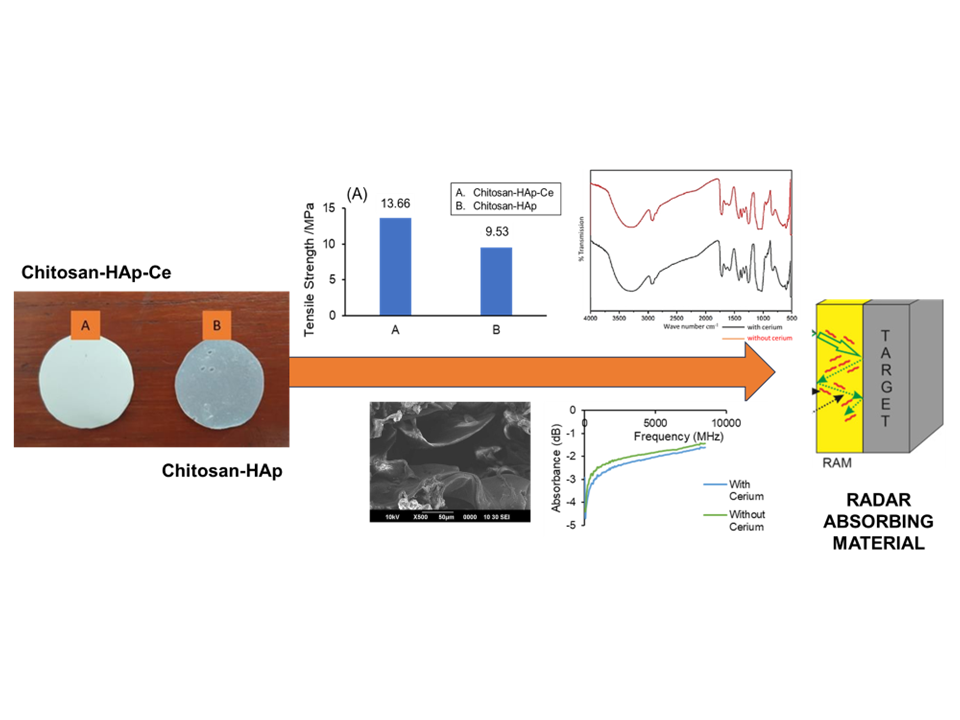Reflection Loss Improvement by Cerium Addition in Chitosan-Hydroxyapatite Film as Stealth Drone Candidate
DOI:
https://doi.org/10.55749/ijcs.v4i1.53Keywords:
Cerium, Chitosan, Hydroxyapatite, Radar absorbing materialAbstract
Radar is a detection and tracking technology commonly applied to monitor environmental conditions. Its ever-growing capabilities pose a serious challenge to military operations because they increase the risk of being detected by the enemy. On the other hand, unmanned aircraft (drones) are increasingly widespread in gathering information. However, the effectiveness of this technology can be reduced due to exposure to radar waves that allow detection. Therefore, developing coating materials that can absorb radar waves is an urgent need to increase the effectiveness of military equipment. The composites developed were derived from chitosan obtained from crustacean waste, hydroxyapatite from eggshell waste, and the rare earth metal cerium obtained from Lapindo Mud. Composites containing cerium metal (Ce) have higher radar signal absorption capabilities than samples without Ce, as evidenced by VNA measurements showing increased absorbance in the 100 MHz - 8.5 GHz frequency range. SEM tests indicate that cerium particles increase the density and homogeneity of the pore structure, with a size range of 17–24 µm. FTIR characterization revealed that Ce was physically bound to the chitosan-HAp composite. Mechanically, the composite with Ce had a maximum tensile stress of 9.512 MPa and a strain of 9.512%, while without the addition of Ce, a stress of 9.529 MPa and a strain of 25.512% was obtained. These findings indicate that integrating rare earth metals in chitosan-HAp composites can improve the material's capability to absorb radar waves, thus having broad prospects for applications in defence technology.
References
Lesmana, D., Permana, Y., Santoso, B., & Infantono, A. 2021. Military drone applications by using indonesian defense equipment for over the horizon operations. Proceeding of Seminar Nasional Sains Teknologi dan Inovasi Indonesia. 2086. 5805. doi: https://doi.org/10.54706/senastindo.v3.2021.149.
Riyanto, E., Martides, E., Pikra, G., Atmaja, T.D., Pramana, R. I., Purwanto, A.J., ... & Prawara, B. 2021. A review of atomic layer deposition for high lithium-ion battery performance. J. Mater. Res. Technol. 15. 5466-5481. doi: https://doi.org/10.1016/j.jmrt.2021.10.138.
Mursida, M., Tasir, T., & Sahriawati, S. 2018. Efektifitas larutan alkali pada proses deasetilasi dari berbagai bahan baku kitosan. Pengolah. Has. Perikan. Indones. 21(2). 356-366.
Zam, Z.Z., Umar, S., Robo, T., & Muin, F. 2020. Isolation and characterization of chitosan from coconut crab skin origin of halmahera island with FTIR. In Proceedings of the 1st International Conference on Teaching and Learning. 298-302. doi: https://doi.org/10.5220/0008901202980302.
Mouritz, A.P. 2012. Introduction to aerospace materials. Elsevier.
Purwanto, D., & Angkoso, A. 2021. Studi eksperimental pengaruh konsentrasi lumpur lapindo sebagai pelarut mixdesain pembuatan bata ringan celullar lightweight concrete (CLC). Sebatik. 25(2). 756-761. doi: https://doi.org/10.46984/sebatik.v25i2.1171.
Agustawijaya, D.S., Karyadi, K., Krisnayanti, B.D., & Sutanto, S. 2017. Rare earth element contents of the Lusi mud: An attempt to identify the environmental origin of the hot mudflow in East Java–Indonesia. Open Geosciences. 9(1). 689-706. doi: https://doi.org/10.1515/geo-2017-0052.
Marpaung, M.A., Iqbal, J., Pardede, M., Bilal, M., Hedwig, R., Ramli, M., ... & Tjia, M.O. 2019. Quantification of rare earth elements with low pressure laser induced breakdown spectroscopy employing subtarget supported micro mesh sample holder. J. Laser Appl. 31. 032001. doi: https://doi.org/10.2351/1.5097756.
Sinha, S., Sinha, M.K., & Pandey, B.D. 2014. Extraction of lanthanum and cerium from Indian red mud. Int. J. Miner. Process. 127. 70–73. doi: 10.1016/j.minpro.2013.12.009.
Maiti, R., Rodriguez, H.G., & Kumari Ch, A. 2015. Trees and shrubs with high carbon fixation/concentration. Forest Res. S1. 003. doi: https://doi.org/10.4172/2168-S1-003.
Irianto, B., Atmojo, S.D., Hapsari, N.A., Firmanda, E., & Fadhallah, E.G. 2013. Prototype teknologi siluman (Stealth) material organik penyerap gelombang radar dari komposit polimer chitosan-hidroksiapatit untuk aplikasi peralatan militer wilayah perbatasan. Prosiding Elektronik Pekan Ilmiah Mahasiswa Nasional Program Kreativitas Mahasiswa-Penelitian.
Usvanda, L.N., & Zainuri, M. 2016. Sintesis dan karakterisasi lapisan radar absorbing material (RAM) berbahan dasar BaM/PANi pada rentang gelombang x-band dengan variasi ketebalan. J. Sains dan Seni ITS. 5(2). 74-79.
Yamazaki, M., & Iwasaki, T. 2013. Evaluating strength of adhesive interface between metal and resin in resin-molded structures. J. Solid Mech. Mater. Eng. 7(1). 54-64. doi: https://doi.org/10.1299/jmmp.7.54.
Tongdeesoontorn, W., Mauer, L.J., Wongruong, S., Sriburi, P., & Rachtanapun, P. 2012. Mechanical and physical properties of cassava starch-gelatin composite films. Int. J. Polym. Mater. Polym. Biomater. 61(10). 778-792. doi: https://doi.org/10.1080/00914037.2011.610049.
Munandar, I., & Savetlana, S. 2013. Kekuatan tarik serat ijuk (Arenga pinnata merr). J. Ilm. Tek. Mesin. 1(3). 97942.
Dadzie, P.K., & Amoah, M. 2015. Density, some anatomical properties and natural durability of stem and branch wood of two tropical hardwood species for ground applications. Eur. J. Wood Wood Prod. 73. 759-773. doi: https://doi.org/10.1007/s00107-015-0925-x.
Zhang, Y., Huang, X., Duan, B., Wu, L., Li, S., & Yuan, X. 2007. Preparation of electrospun chitosan/poly (vinyl alcohol) membranes. Colloid Polym. Sci. 285. 855-863. doi: https://doi.org/10.1007/s00396-006-1630-4.
Ramahdita, G., Puspita, D.M., Albab, M.F., Alfata, R., Sofyan, N., & Yuwono, A.H. 2018. The effect of hydroxyapatite addition on the mechanical properties of polyvinyl alcohol/chitosan biomaterials for bone scaffolds application. AIP Conf. Proc. 1933(1). 20006. doi: https://doi.org/10.1063/1.5023940.

Downloads
Published
How to Cite
Issue
Section
License
Copyright (c) 2025 Indonesian Journal of Chemical Studies

This work is licensed under a Creative Commons Attribution-ShareAlike 4.0 International License.


















